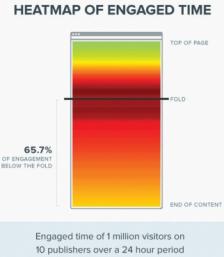Do online comments build a premium news brand? Advertisers might think so

Below the fold — that’s where the ad revenue is.
That is, at least, current thinking.
New insight into how people interact with Web pages shows that the most engaging content often takes the audience “below the fold,” to the comments. This runs counter to commonly used online ad strategies that sell the top of the page as the most valuable real estate. It’s often not. When the content is compelling for the audience – they increasingly head to the comments to learn more and share their point of view. Where the audience goes, the advertisers go.
As I wrote recently, publishers are beginning to embrace the value of moderation in creating community and bringing value to their reporting. But as important, an active community that reads and comments and discusses articles also brings value to advertisers.
Real time data analyst ChartBeat has invented metrics for measuring audience interaction called Engaged Time and a heat map tool for viewing it. As they say in their blog:
Average Engaged Time is a Chartbeat metric that measures the amount of time that users spend actively interacting with a page – reading, writing, scrolling, watching – and it’s a great place to start when looking at how well your content matches with your audience. ...
Pages with high Engaged Time are likely being read by your most loyal audience. These pages are your best candidates for things like subscription links and newsletter signups that are designed to take interested readers and make them directly loyal to your site.
The unifying message ... is that you want to try to put the right content in front of the right audience.
Viewers who visit daily, who spend the most time, who comment on news stories are the most passionate members of the audience. These readers make comment sections some of the most valuable real estate on a site for advertisers.
“Chartbeat, or any analytics tool that tells you where readers spend the most time is definitely valuable because it helps shine a light on ad space that most advertisers didn't previously think was visible or worth paying for,” said Kenny Katzgrau, co-founder of Broadstreet Ads, which serves community publishers. Other tools providing heat maps include CrazyEgg and ClickDensity.
So called “page-view journalism” doesn’t really honor the engagement metric, and as Pew said in its recent report.
The findings suggest that there is not one group of news consumers online but several, each of which behaves differently. These differences call for news organizations to develop separate strategies to serve and make money from each audience.
Clearly, creating a better experience below the fold serves an important audience of passionate readers and commentors.
“When you think about it Gawker, Buzzfeed, Huffington Post – what is at the base of all of these properties at some level is that they have a very distinct brand,’ said Steve Roy, VP, Marketing and Communications at DISQUS, “and their readers are not spending their time at the top of the pages.”
Souping up online comments
In fact, these news sites are souping up their comment sections. Huffington Post announced “Conversations,” and Gawker is using new technology called Kinja. Other large publishers are creating brand ambassadors, volunteer moderators and similar roles uniquely suited to their most loyal, active users. The imminent next step is to sell advertising against them.
“You cannot copy a community. You cannot clone a premium brand,” said Roy, whose employer DISQUS has developed a tool to sell advertising within active comment threads.
As smaller news publishers devise comment policies, they need to consider the quality of their online comments as an asset that could directly translate into cash. And then find the right tools to communicate that brand value to their advertisers.
Krazgau said heat map tools like ChartBeat may be especially useful for smaller publishers who directly sell to advertisers. “From an advertiser's perspective, ad space below the fold, near the discussion thread doesn't seem as attractive as the leaderboard at the top of the page. But if you can actually prove that readers spend a significant amount of time there, perhaps the discussion changes, and under-monetized ad space gets sold.”
Tools for managing online comments
Discourse is 100% free open source software, currently in early Beta.
The code is currently only available from GitHub. It promises innovations the include links that automatically expand within a comment, similar to Twitter as well as a reputation system.
Beautiful, real-time, engaging discussions for your website.
With a few quick steps, you can turn your old comment system into a new way to engage your visitors. From small blogs to massive websites, Disqus is the easiest way to build active communities. It's free to use and works with virtually any type of website.
IntenseDebate is a feature-rich comment system for WordPress, Blogger, Tumblr and many other blogging/CMS platforms.
Livefyre’s real-time apps get your audience talking and turn your site into the hub for your community. Bloggers, brands and the largest publishers in the world use Livefyre to engage their users and curate live content from around the social web.
What is ProConIt?
ProConIt is the world’s first Social Evaluation platform. The better way to evaluate anything quickly, precisely and intelligently—all in an easy-to-build, fun package.
Realtidbits gets its name from two parts: the real in real-time and the bits in tidbits. Together we enable publishers to create a social layer on top of their content where users can share their reactions with each other. What follows are some of the high-level features our products tout. But the real value comes from how you work with our products.
Read a roundup on the business of online comments from ReadWriteWeb.



